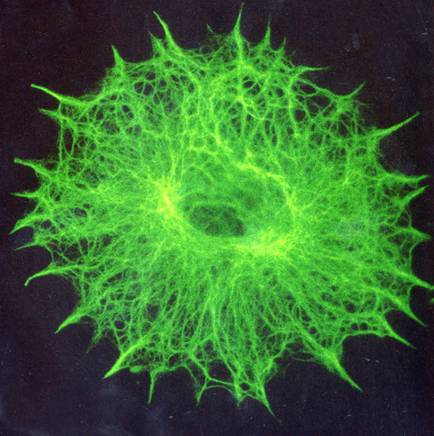The point of this series is to understand the wild and crazy unusual cells that populate the world (and that populate us!). But we should first understand the usual cell... or, perhaps, we will find that there is no such thing as a usual cell.
Consider the cartoon eukaryotic cell that we all know and, presumably, love:
 Figure 1: Typical eukaryotic cell. I'll refrain from listing the organelles, in order to prevent yawning; if you're curious, check Wikipedia, where this image is from.
Figure 1: Typical eukaryotic cell. I'll refrain from listing the organelles, in order to prevent yawning; if you're curious, check Wikipedia, where this image is from.So... what's wrong with this cell? Here's a sampling of some of the answers my Splash students have given me:
- You can't see the DNA
- You can't see the proteins
- It's cut in half (yes, some of them are smartasses)
- There are no membrane proteins
The answer I'm really looking for is this:
It's empty!
(To be fair, Splash students pretty much always get this one too, and it's a general case of the answers I gave above except for #3.)
There's nothing in this cell! Yes, the major organelles are there, but where is the cytoskeleton? It's just that tiny little fiber (#7), which you can barely even see. Real cells are just packed with stuff. Structural proteins, membrane proteins, highways of vesicles wandering to and fro...
Now, of course, this is kind of a necessary evil. We can't include all that stuff in cartoons of the cell that are supposed to show the major organelles, because it would just be a distraction. Visual noise. For example, check out this slice of a more realistic watercolor:
 Figure 2: You can see a bit of the Golgi (yellow stacks) in this picture. The geodesic-dome-looking thing is a protein framework that's making a vesicle bud out from the Golgi. [Source]
Figure 2: You can see a bit of the Golgi (yellow stacks) in this picture. The geodesic-dome-looking thing is a protein framework that's making a vesicle bud out from the Golgi. [Source]Seriously, check out the whole thing. It's beautiful. If I could get a quality print of this I would hang it above my bed. But even this is far from showing everything. The empty space between all those blobs is filled with crazy amounts of ions, small molecules, and of course water.
For a different perspective, check out these photos of cells in which the cytoskeleton has been labeled with green fluorescence. Yep, that's just the cytoskeleton... it reaches everywhere, helping the cell maintain its shape and move around (just like the human skeleton), and giving direction to packages of important chemicals as they motor their way hither and thither (something like the human circulatory system).


To do: find out what percentage of the membrane surface area is proteins. I know this is in one of my textbooks somewhere.


